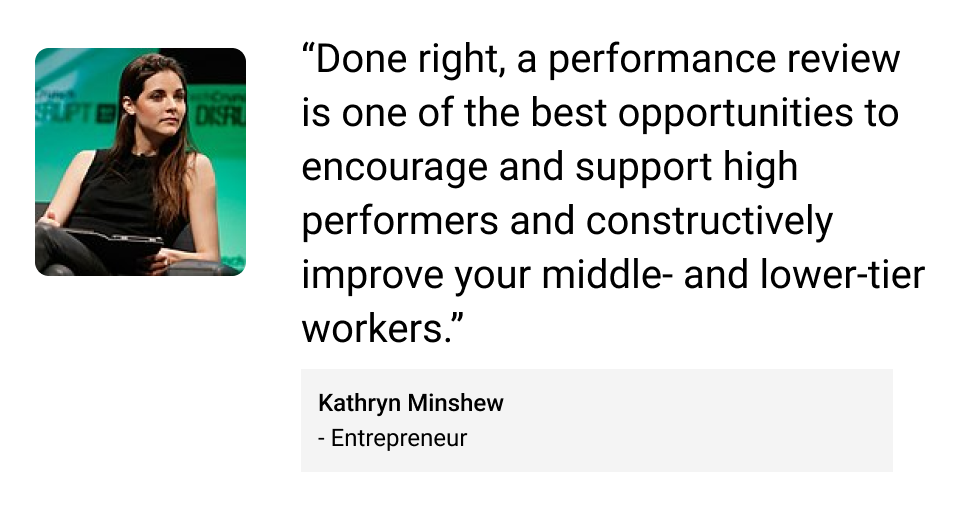Imagine receiving feedback that says, ‘Your work is consistently late and careless.’ ⏰? Now picture a different approach: ‘Let’s find ways to help you meet deadlines.The first employee evaluation comment can demoralize even the hardest worker, while the second fosters collaboration and improvement. This distinction can make or break a team’s performance. It highlights the importance of sharing quality employee performance evaluation comments and recommendations.
Having spent nearly a decade in the e-learning and training industry, I understand the critical role that positive and constructive feedback plays in employee evaluations. Here’s a detailed guide to performance reviews, their significance, and practical employee evaluation examples to help cultivate a positive workplace culture.
Look at this data:
17% of employees feel that the feedback they get is not specific.
Less than 3 in 10 employees think their performance reviews are fair and accurate.
Only half of the employees understand what’s expected of them at work.
These stats highlight the importance of the quality of employee performance evaluation comments.To ensure your employees get the right message on their performance, you need to keep your comments specific and remove any room for ambiguity.
Also, even when the performance is negative, you should never make your comments way too harsh.
The idea is to enable your employees to understand where they performed well and where they can improve — without feeling confused and demotivated.
With this in mind, in this post, we look at the 100 best examples of employee reviews with a specific focus on comments. They are arranged under different key performance areas (KPAs) to help you learn the right feedback to provide to your employees.

Why Employee Evaluation Comments Are Important?
Employee evaluation comments are like feedback sandwiches – they help employees understand their strengths and areas for improvement. These comments are crucial because they provide specific insights into an employee’s performance beyond just a numerical rating.
For example, imagine a soccer player receiving a performance review. A simple “good job” doesn’t help them improve. But comments like “Your passing accuracy was excellent, but you could work on your defensive positioning” provide specific guidance.
Similarly, employee evaluation phrases offer actionable feedback that allows employees to understand their performance better and take concrete steps to enhance their skills.
How to Write An Employee Evaluation (With Examples)

An effective employee evaluation requires a structured approach that focuses on strengths and improvement areas. Here’s a guide to help you draft a clear and constructive evaluation:
1. Begin With the Purpose
Clearly state the purpose of the evaluation to set the tone. Whether it’s an annual review, a performance improvement plan, or a routine check-in, clarify the purpose for both you and the employee.
2. Review Job Description and Responsibilities
Base your evaluation on the employee’s actual role and responsibilities. Align your feedback with specific tasks and expectations outlined in their job description to ensure fairness.
3. Highlight Strengths
Acknowledge areas where the employee excels. Be specific:
- Cite examples of tasks they have completed well.
- Describe how their strengths benefit the team or company.
Here’s an employee evaluation comment example to get a better idea: “John consistently exceeds expectations in managing client relationships, which has contributed to a 20% increase in customer retention.”
4. Provide Constructive Feedback
Address areas for improvement with a focus on growth:
Be specific about what needs improvement.
Offer actionable suggestions or resources to help them improve.
Here’s an example of employee evaluation in a constructive manner: “While Sarah shows great initiative, improving time management would help her meet deadlines more consistently. Utilizing project management tools could assist with this.”
5. Discuss Achievements and Results
Focus on measurable results. Include data or metrics wherever possible to illustrate their performance objectively.
Here’s an employee evaluation example that discusses results: “During the last quarter, Mike successfully led the launch of the new marketing campaign, which generated a 30% increase in web traffic.”
6. Set Clear Goals for the Future
Collaboratively set SMART (Specific, Measurable, Achievable, Relevant, Time-bound) goals for future improvement and growth. Make sure they align with the company’s broader objectives.
Example: “For the upcoming year, we will aim to increase your sales targets by 10% and focus on enhancing your presentation skills.”
7. Encourage Two-Way Feedback
Make the evaluation a dialogue, not just a monologue. Encourage the employee to share their own feedback on their performance and discuss how management can support their development purposes better.
8. End on a Positive Note
Reinforce the employee’s value to the team and express confidence in their ability to grow and succeed.
Example: “Overall, your contributions have been highly valued, and we look forward to seeing you achieve even greater results the next year.”
9. Document the Evaluation
Ensure the evaluation is documented in writing for future reference. This creates a record of performance discussions and goals agreed upon.
Examples of Employee Evaluation Comments & Phrases
Here’s a collection of 100+ examples of employee evaluation comments and phrases used in performance reviews:
1. Productivity Review Comments
Positive Examples
- Consistently delivers work that exceeds expectations, completing tasks ahead of schedule without compromising on quality.
- Demonstrates a strong work ethic, often taking on additional tasks while maintaining a high level of efficiency.
- Manages time exceptionally well, balancing multiple projects and ensuring deadlines are met with ease.
- Shows impressive focus and drive, regularly surpassing productivity goals and inspiring others to do the same.
Constructive Examples
- Could benefit from improving prioritization to handle tasks more efficiently, which will lead to even greater productivity in the future.
- With a little more consistency in workflow, you can reach your full potential and make an even bigger impact.
- By minimizing distractions and maintaining focus, you’ll find that you can achieve much more during the day.
- With some strategic planning, you’ll be able to handle increased responsibilities and still meet deadlines.
2. Teamwork Review Comments
Positive Examples
- Works exceptionally well with others, often stepping in to support teammates and ensuring the success of the group as a whole.
- Brings a positive attitude to collaborative efforts, always encouraging others and helping the team stay motivated.
- Actively contributes to team discussions, offering valuable insights that drive projects forward.
- Promotes a culture of inclusivity and teamwork, making sure every team member feels heard and valued.
Constructive Examples
- By actively seeking feedback from team members, you can enhance collaboration and strengthen team dynamics.
- Continuing to focus on open communication will further boost your effectiveness in working alongside others.
- Embracing more collaboration opportunities will allow you to utilize your skills and strengthen team output fully.
- Building on your existing teamwork skills and focusing on shared goals can make your collaboration efforts even more impactful.
3. Leadership & Management Skills Review Comments
Positive Examples
- Leads the team confidently and clearly, ensuring everyone is aligned with the project’s goals and expectations.
- Empowers team members by delegating effectively and offering guidance that encourages growth.
- Leads by example, maintaining a strong work ethic and setting high standards for the team to follow.
- Offers constructive feedback that motivates and supports team members, fostering a positive environment.
Constructive Examples
- With more proactive communication, you can provide even clearer direction to the team, helping them thrive.
- By providing feedback more regularly, you can help team members stay on track and grow in their roles.
- Delegating tasks more effectively will allow your team to feel more empowered and trusted, enhancing overall performance.
- Building trust with the team through open and transparent communication will strengthen your leadership presence.
4. Time Management Skills Review Comments
Positive Examples
- Always demonstrates exceptional time management skills, ensuring tasks are completed before schedule without sacrificing quality.
- Efficiently manages a variety of projects, making sure that each is completed promptly.
- Balances priorities well, staying focused on high-impact tasks while consistently meeting deadlines.
- Exhibits excellent organizational skills, ensuring that no deadlines or responsibilities are missed.
Constructive Examples
- With a little more focus on prioritizing tasks, you’ll find it easier to meet deadlines while maintaining a high standard of work.
- By breaking tasks into smaller steps, you could enhance your ability to meet deadlines during high-pressure periods.
- Developing a habit of scheduling more time for high-priority tasks will help you handle heavier workloads more efficiently.
- By refining your time management strategies, you’ll be able to accomplish more without feeling overwhelmed.
5. Communication Skills Review Comments
Positive Examples
- Communicates clearly and effectively, ensuring that all team members are informed and aligned on project goals.
- Shows great listening skills and provides valuable, well-thought-out feedback that enhances team collaboration.
- Speaks confidently and clearly, making it easy for others to understand complex ideas and concepts.
- Promotes open communication, making sure that every team member feels heard and included in discussions.
Constructive Examples
- As you continue to build on your communication skills, focusing on more concise updates will help ensure everyone stays informed.
- By actively seeking input from others, you’ll foster even stronger communication within the team.
- You’re already a strong communicator, and with more emphasis on sharing ideas openly, your impact can grow even more.
- Enhancing your communication style to ensure clarity in complex discussions will further improve team understanding and collaboration.
6. Learning & Development Review Comments
Positive Examples
- Proactively seeks out learning opportunities, always eager to expand skills and apply new knowledge to improve performance.
- Quickly adapts to new tools and processes, showing a commitment to both personal and professional growth.
- Embraces change and continually seeks ways to learn and grow, keeping up with industry trends and advancements.
- Shows a genuine passion for development, regularly attending training sessions and bringing fresh ideas to the table.
Constructive Examples
- Pursuing more professional development opportunities will help you stay ahead of industry trends and sharpen your skills.
- By taking the initiative to explore new learning resources, you’ll be able to expand your expertise and advance your career.
- Focusing on developing new skills outside of your comfort zone will open up exciting growth opportunities.
- Embracing change and being open to continuous learning will further enhance your effectiveness in your role.
7. Creativity & Innovation Review Comments
Positive Examples
- Regularly brings fresh, creative ideas to the table, contributing to process improvements and innovative solutions.
- Shows a natural ability to think outside the box, offering creative approaches that lead to successful outcomes.
- Encourages the team to embrace new ideas, fostering an environment where innovation thrives.
- Always willing to experiment with new methods, driving creative problem-solving across projects.
Constructive Examples
- Exploring more unconventional solutions can help unlock new levels of creativity in your work.
- By continuing to embrace a mindset of innovation, you’ll inspire even more creative approaches to challenges.
- Taking calculated risks and exploring alternative methods will allow you to tap into your full creative potential.
- Experimenting with new ideas will lead to exciting breakthroughs and push your creativity even further.
8. Interpersonal Skills Review Comments
Positive Examples
- Builds strong, positive relationships with colleagues, contributing to a harmonious and collaborative work environment.
- Is always approachable and helpful, fostering trust and cooperation among team members.
- Demonstrates empathy and understanding, effectively resolving conflicts and maintaining team harmony.
- Contributes to a positive workplace culture, encouraging open dialogue and teamwork.
Constructive Examples
- By focusing on deepening connections with colleagues, you’ll further enhance teamwork and mutual respect within the team.
- Strengthening your interpersonal relationships will create even more effective collaborations and a supportive work atmosphere.
- Building more trust through open conversations will help create a stronger and more cohesive team dynamic.
- By focusing on active listening and understanding diverse perspectives, you’ll improve collaboration and workplace harmony.
9. Punctuality Review Comments
Positive Examples
- Always arrives on time and ready to contribute, showing great respect for the schedules of others.
- Exemplifies punctuality, consistently arriving early to meetings and ensuring that work is completed within set timeframes.
- Is consistently dependable when it comes to attendance and punctuality, ensuring smooth project flow.
- Regularly meets all deadlines and is always punctual, setting a great example for the rest of the team.
Constructive Examples
- Focusing on small adjustments to your routine will help ensure you’re consistently on time for meetings and deadlines.
- By refining your time management strategies, you’ll find it easier to maintain punctuality, even during busy periods.
- Making minor improvements to your schedule will help you manage your time more effectively and ensure timely attendance.
- By paying closer attention to your time management, you’ll set a stronger example for others and improve overall punctuality.
10. Goal Achievement Review Comments
Positive Examples
- Regularly exceeds performance goals, always striving to raise the bar and drive success for the team.
- Achieves or surpasses all targets with a high degree of consistency, contributing to the overall success of the department.
- Sets ambitious goals and works hard to achieve them, showing dedication and a results-oriented mindset.
- Not only meets set targets but frequently goes above and beyond, delivering exceptional results.
Constructive Examples
- By setting smaller, more manageable milestones, you’ll be able to achieve long-term goals more effectively.
- Refining your focus on key objectives will help you align your efforts with the company’s broader goals.
- Breaking down your larger goals into actionable steps will help you see progress more clearly and stay motivated.
- With a more strategic approach to goal setting, you’ll find yourself achieving even greater results.
11. Problem-Solving Skills Review Comments
Positive Examples
- Tackles challenges head-on, quickly identifying effective solutions even in high-pressure situations.
- Demonstrates excellent problem-solving skills, thinking critically and creatively to overcome obstacles.
- Excels at finding solutions that not only solve the problem but also improve processes for future projects.
- Approaches challenges with a calm and logical mindset, always ready to tackle any problem with confidence.
Constructive Examples
- By continuing to refine your analytical skills, you’ll become even more adept at solving complex problems.
- Taking a step back to assess problems from different angles will help you develop even more innovative solutions.
- Exploring alternative problem-solving approaches will enhance your ability to tackle diverse challenges.
- With a more systematic approach, you’ll improve your problem-solving process and produce even more effective solutions.
12. Initiative Review Comments
Positive Examples
- Proactively takes on new challenges and projects, demonstrating a strong sense of initiative and leadership.
- Often goes above and beyond assigned tasks, identifying areas for improvement and acting on them without being prompted.
- Shows great initiative in finding solutions to problems, often resolving issues before they escalate.
- Demonstrates a forward-thinking mindset by consistently looking for opportunities to enhance processes and performance.
Constructive Examples
- By identifying more opportunities to take ownership of tasks, you’ll further develop your leadership skills and make a more substantial impact.
- Exploring new areas within your role will open up more growth opportunities and build your expertise.
- With a little more confidence in suggesting new ideas, you’ll inspire others and contribute to innovative solutions.
- You’ll gain valuable experience and drive even greater team success by stepping forward and taking on more responsibilities.
13. Reliability Review Comments
Positive Examples
- Can always be counted on to deliver high-quality work, consistently meeting deadlines and exceeding expectations.
- Demonstrates a high level of reliability, often being the go-to person for completing complex or time-sensitive tasks.
- Is highly dependable, consistently following through on commitments and ensuring tasks are completed on time.
- Shows great reliability in handling responsibilities, often going the extra mile to ensure successful project completion.
Constructive Examples
- By continuing to build on your consistency, you’ll further enhance your reputation as a reliable team member.
- Developing a stronger routine for task completion will help you maintain your reliability, even during busy periods.
- Focusing on improving follow-up on smaller tasks will enhance your dependability and overall effectiveness.
- Building a more organized approach to your workload will allow you to manage responsibilities more reliably and efficiently.
Do not miss this case study: How CDPH Reduced Training Costs & Improved Employee Performance
How to Deliver Employee Evaluation Comments Effectively

Now that we’ve seen some employee evaluation comment examples, let’s understand how to deliver them effectively.
1. Focus on Specific Behaviors
Mention specific instances of work performance rather than vague assessments. This provides clarity and avoids misunderstandings.
Example: “Your ability to manage multiple projects simultaneously has been impressive, particularly with the recent client project.”
2. Balance Positive and Constructive Feedback
Start with positive phrases for employee evaluations to ease the conversation, then move to improvement areas. Highlight what works well and provide actionable advice on what needs to change.
Example: “Your leadership during team meetings has been great, but there’s room to improve on delegating tasks to ensure everyone contributes.”
3. Use a Growth-Oriented Approach
Frame feedback as opportunities for growth. Focus on the potential for improvement rather than highlighting failures.
Example: “I see potential in your presentation skills. With some more practice, I believe you could take lead roles in future client pitches.”
4. Be Direct, Yet Compassionate
Deliver your comments in a straightforward manner, but remain empathetic. This helps employees understand the seriousness without feeling demotivated.
Example: “The recent delays in project deadlines are concerning. Let’s work on a time-management plan to help you stay on track.”
5. Encourage Open Dialogue
Create space for employees to respond or ask questions about their evaluation. This promotes a two-way conversation and helps to clear up any miscommunication.
Example: “How do you feel about your performance on the project, and what support do you think you might need?”
6. Align Feedback with Career Development
Tie your comments to the employee’s professional development and future opportunities within the company.
Example: “Your skills in customer relations have really grown, and I’d like to discuss how we can further expand your responsibilities in this area.”
Get Free Employee Training Software — All Features, Forever.
We've helped 567 companies train 200,000+ employees. Create courses in under a minute with our AI LMS or use 200+ ready-made courses on compliance, harassment, DEI, onboarding, and more!
Enhance Employee Performance With Impactful Reviews
Hopefully, these employee review examples give you an idea of how to phrase the comments clearly so that employees find it easy to work on future expectations. Periodic employee evaluations are an important annual ritual in any organization. But what’s more consequential is how you summarize your assessments.
Objective evaluations and putting them in concise words with employee evaluation comments are the best way to get your message across as these employee performance review sample comments show. Provide the right feedback to the right employees, whether they are star performers or someone who needs to pull their socks up. Keep them motivated and learn from their performance shortfalls. Most importantly, wherever required, train them to create solid human resource assets that can help you build a better organization.
Frequently Asked Questions
Can I use AI to write employee evaluation comments?
Yes, you can use AI to help draft employee evaluation comments. AI tools can generate suggestions based on input about an employee’s performance. However, it’s important to customize these comments to fit the individual’s specific achievements and challenges. Personalizing the feedback ensures it feels genuine and relevant, making it more impactful.
What should I avoid when writing evaluation comments?
When writing evaluation comments, avoid vague language and overly negative tones. Stay clear of personal attacks or comparing employees to each other, as this can hurt morale. Also, don’t use jargon or technical terms that might confuse the employee. Focus on being clear, constructive, and specific about their strengths and areas for improvement.
How often should employee evaluations be conducted?
Employee evaluations should ideally be conducted at least once or twice a year. This frequency allows for regular feedback and development discussions. Additionally, consider having informal check-ins more often to address issues promptly and support employees in their roles. Frequent feedback helps keep everyone aligned and motivated.
How can I provide constructive criticism without demotivating my team?
To provide constructive criticism without demotivating your team, start with positive feedback before discussing areas for improvement. Use “I” statements to express your observations, focusing on the behavior rather than the person. Encourage open dialogue and offer specific examples and actionable suggestions, making it clear that you’re there to support their growth.
What is the difference between performance evaluation and employee evaluation?
Performance evaluation focuses on how well employees meet their job duties and goals, often looking at skills and results. On the other hand, employee evaluation can include broader aspects such as teamwork, attitude, and cultural fit within the organization. Both evaluations are important but serve slightly different purposes in assessing employee value.
How to phrase constructive criticism to avoid demotivation
When phrasing constructive criticism, use a positive and supportive tone. Start by acknowledging the employee’s strengths, then clearly explain the area needing improvement, using specific examples. Suggest practical steps they can take to enhance their performance. By framing the feedback as a collaborative effort for their growth, you help maintain motivation and encourage improvement.
 Tips
Tips
We’d love to hear your tips & suggestions on this article!
Get Free Employee Training Software — All Features, Forever.
We've helped 567 companies train 200,000+ employees. Create courses in under a minute with our AI LMS or use 200+ ready-made courses on compliance, harassment, DEI, onboarding, and more!

 We'd love your feedback!
We'd love your feedback! Thanks for your feedback!
Thanks for your feedback!






